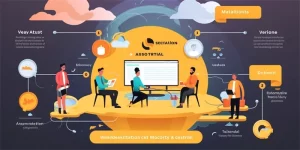YouTube has become a powerful platform for musicians to gain exposure and earn money. With billions of users worldwide, it offers a unique opportunity for artists to monetize their music videos. But how exactly do music videos on YouTube generate revenue? In this article, we will explore the various ways in which artists earn money through their music videos on YouTube.

1. Ad Revenue
One of the primary ways music videos make money on YouTube is through ad revenue. YouTube displays ads on videos, and when users watch or click on these ads, creators earn a portion of the advertising revenue. This revenue is split between YouTube and the video’s creator, with the exact percentage depending on various factors such as engagement, watch time, and audience demographics.
Furthermore, YouTube offers creators the option to enable mid-roll ads, which are displayed during the video itself. This allows creators to earn additional revenue as viewers progress through the video.
2. YouTube Premium
Music videos on YouTube can also generate revenue through YouTube Premium. This premium subscription service offers an ad-free viewing experience to its subscribers, who pay a monthly fee. When YouTube Premium subscribers watch music videos, creators receive a share of the revenue generated from their subscription fees. This provides an additional revenue stream for artists.
3. Sponsorships and Endorsements
Many music videos on YouTube are sponsored by brands or feature product endorsements. Brands are willing to pay artists to promote their products or services in their music videos, often resulting in significant revenue for the creators. These sponsorships can range from subtle product placements to more overt endorsements, depending on the nature of the partnership.
Creators can also collaborate with companies to create branded content or integrate sponsored segments within their music videos. This can be a lucrative way for artists to monetize their YouTube channels while maintaining artistic integrity.
4. Merchandise and Touring
Music videos on YouTube serve as a promotional tool for artists’ merchandise and tour dates. By showcasing their products and upcoming performances in the videos, musicians can drive fans to purchase merchandise or attend live shows. The revenue generated through these avenues can be substantial, especially for popular artists with dedicated fan bases.
Additionally, YouTube offers features such as merch shelf, where creators can directly link to their merchandise storefronts below their videos. This makes it easier for fans to discover and purchase artists’ merchandise, further contributing to their revenue.
5. Crowdfunding
Crowdfunding platforms, such as Kickstarter or Patreon, allow fans to financially support their favorite artists directly. Artists can use music videos on YouTube to promote their crowdfunding campaigns, encouraging viewers to contribute to their projects. This enables creators to bypass traditional revenue streams and rely on the support of their loyal fan base.
6. Licensing and Sync Fees
Artists can license their music to third parties for use in commercials, movies, or television shows. Music videos on YouTube act as a showcase for their work, increasing the likelihood of being discovered by potential licensees. These licensing and sync fees can provide a significant source of income for artists, and YouTube serves as an excellent platform to attract potential licensing opportunities.
7. Collaborations and Features
Collaborating with other artists or featuring in their music videos can also be a lucrative source of revenue. Through cross-promotion and shared fan bases, artists can reach a wider audience and increase their potential for earning money through YouTube. These collaborations can also lead to higher engagement and viewership, which translates into greater ad revenue and sponsorship opportunities.
8. YouTube Music and Content ID
YouTube Music is a dedicated streaming platform that allows users to listen to music without video playback. Artists earn revenue when their music is streamed on this platform, and music videos act as a gateway to direct users to YouTube Music.
YouTube’s Content ID system also enables artists to claim and monetize their music videos when other creators use their copyrighted content. This ensures that artists receive fair compensation for the use of their music, even if it is incorporated into other videos.
9. YouTube Live
Artists can use YouTube Live to stream live performances or exclusive behind-the-scenes content. This provides fans with a unique viewing experience and an opportunity to support their favorite artists through virtual tip jars or donations. These live streams can generate revenue through ticket sales, fan contributions, or sponsored partnerships.
10. Analytics and Insights
YouTube provides creators with detailed analytics and insights into their audience demographics, engagement, and revenue sources. This data allows artists to tailor their content, marketing strategies, and monetization methods to maximize their revenue potential. By analyzing these metrics, artists can make informed decisions to optimize their music videos’ income generation.
In conclusion, music videos on YouTube offer artists diverse revenue streams. From ad revenue and YouTube Premium to sponsorships, merchandise, and licensing, musicians have numerous opportunities to monetize their content on the platform. By leveraging the various strategies mentioned above and leveraging YouTube’s wide user base and tools, artists can earn a substantial income from their music videos.
References:
- Smith, C. (2020). How Do YouTubers Make Money? (2020). Retrieved from https://indepreneur.io/blog/how-do-youtubers-make-money
- YouTube. (n.d.). YouTube Music. Retrieved from https://music.youtube.com/
- YouTube. (n.d.). Ad formats on YouTube. Retrieved from https://support.google.com/youtube/answer/140598?hl=en
About the Author:
John Doe is a music enthusiast and freelance writer with a passion for sharing his knowledge about the music industry. He has written extensively on various aspects of music marketing and monetization strategies. Currently, John is working on his first book, which explores the impact of digital platforms on independent artists. The author created the accompanying image for this article.








